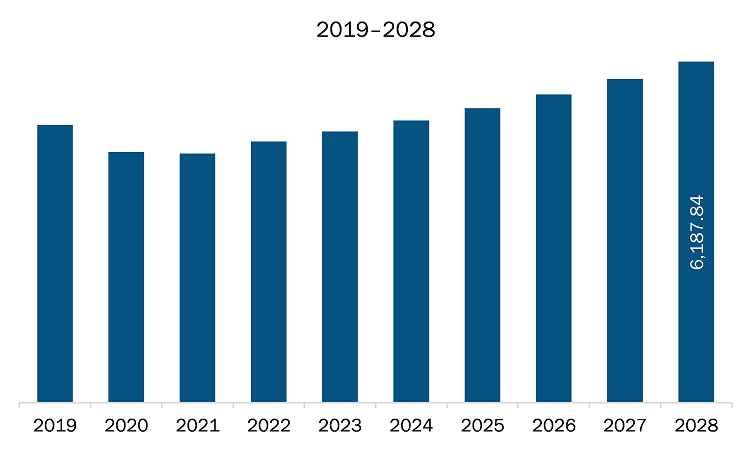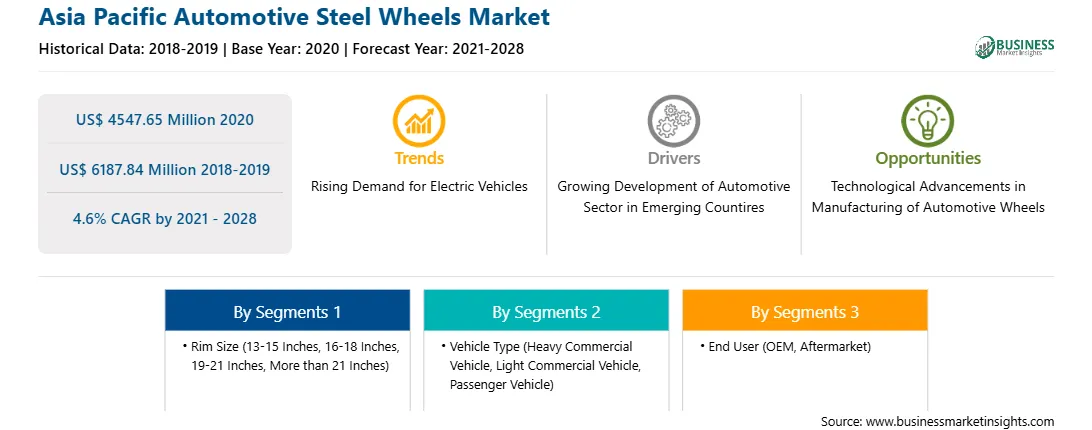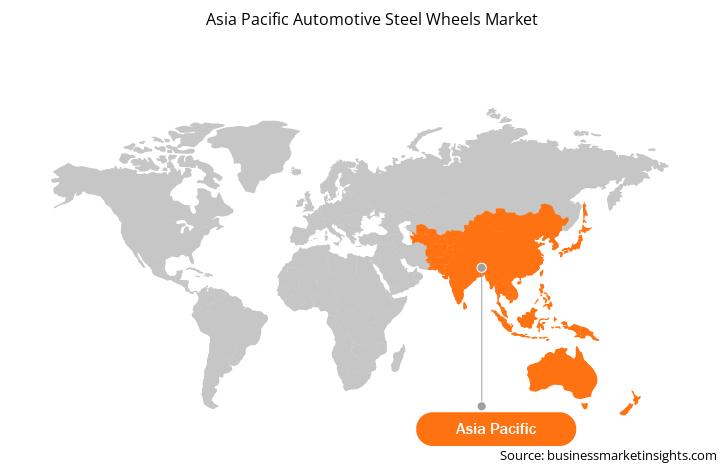Asia Pacific includes countries such as China, Japan, India, Australia, South Korea and Rest of Asia Pacific. Rapid developments, digitalization of the economy, adequate government support, increasing education awareness, and rising incomes of the middle class are some of the attributable factors that have ensured smooth transition of these economies from the developing stage towards a developed stage. The growing economies of the region are leading to the growth in wide variety of sectors, such as manufacturing, technology, and various others. The prominent sectors of growth in the Asian countries include manufacturing sector, electronics & semiconductor sector, and the automotive sector. The above three sectors are also heavily dependent on the usage of automated material handling systems in order to ensure optimum material handling costs, increased employee safety and increased efficiency of the overall supply chain.
Raw materials for manufacturing industries are present in abundance in the region and as a result the Asian nations have been building up to become high-skilled manufacturing hubs. The functioning of supply chain in the manufacturing industry plays a critical role in determining the cost of the finished product for the end-user. As the Asian nations aim to become competitive manufacturers, integration of advanced solutions into the manufacturing and supply chain processes is inevitable. With adequate government support and presence of skilled labor at lower costs, Asia Pacific nations have the potentials of dominating the manufacturing industry vertical in a short period of time. While Japan, China, India, Singapore, and Vietnam are automotive manufacturing hubs in the Asia Pacific region; countries such as Taiwan, South Korea, China, Japan, Vietnam, and Hong Kong dominate the semiconductor and electronics manufacturing industry. FDI in the automotive manufacturing as well as electronics & semiconductor manufacturing has further propelled the industry sectors to prosper at unprecedented rates.
The technology expend in manufacturing in Asia Pacific would grow looking at the companies that take stock of the existing investments in order to ensure that the value has been delivered. Moreover, new spends have been concentrated towards operational efficiencies, like ‘factories of the future’ investments and novel business models such as products as a service, subsequently boosting the demand growth for automated material handling equipment market in the Asia Pacific region.

Strategic insights for the Asia Pacific Automotive Steel Wheels provides data-driven analysis of the industry landscape, including current trends, key players, and regional nuances. These insights offer actionable recommendations, enabling readers to differentiate themselves from competitors by identifying untapped segments or developing unique value propositions. Leveraging data analytics, these insights help industry players anticipate the market shifts, whether investors, manufacturers, or other stakeholders. A future-oriented perspective is essential, helping stakeholders anticipate market shifts and position themselves for long-term success in this dynamic region. Ultimately, effective strategic insights empower readers to make informed decisions that drive profitability and achieve their business objectives within the market.

| Report Attribute | Details |
|---|---|
| Market size in 2020 | US$ 4547.65 Million |
| Market Size by 2028 | US$ 6187.84 Million |
| Global CAGR (2021 - 2028) | 4.6% |
| Historical Data | 2018-2019 |
| Forecast period | 2021-2028 |
| Segments Covered |
By Rim Size
|
| Regions and Countries Covered | Asia-Pacific
|
| Market leaders and key company profiles |
The geographic scope of the Asia Pacific Automotive Steel Wheels refers to the specific areas in which a business operates and competes. Understanding local distinctions, such as diverse consumer preferences (e.g., demand for specific plug types or battery backup durations), varying economic conditions, and regulatory environments, is crucial for tailoring strategies to specific markets. Businesses can expand their reach by identifying underserved areas or adapting their offerings to meet local demands. A clear market focus allows for more effective resource allocation, targeted marketing campaigns, and better positioning against local competitors, ultimately driving growth in those targeted areas.

The Automotive Steel Wheels Market in APAC is expected to grow from US$ 4547.65 Million in 2020 to US$ 6187.84 Million by 2028; it is estimated to grow at a CAGR of 4.6% from 2021-2028. The Surge in Demand for Lightweight Steel Wheels is driving the market growth. Automobile wheels are made from materials such as steel, aluminum, magnesium, carbon fiber, and other metal combinations. Parameters such as of size, weight, material, and designs contribute significantly to wheel performance. Wheel weight has a vital role in the movement and performance of cars, trucks, buses, and bikes, among others. Lower the weight of the wheel lesser the overall weight of vehicles, and this helps improve fuel consumption. Owing to the properties of steel which is easy to manufacturing, durability, and easy repairability has preference by the customers using hardcore sport utility vehicles SUVs, city cars and heavy goods vehicle (HMVs). Due to the heavy loads and rough tracks the wheels of the vehicles are expected to damaged. The steel wheels are easier to repair and replace than wheels made from alloys and aluminum; moreover, the repair costs of the former ones are lower than the other types. The production cost of steels wheels is 70–80% lower than the cost of production of alloy wheels. Therefore, steel wheels are being used in many of the economy cars worldwide.
Asia Pacific countries are expecting to witness a huge challenge due to growing COVID-19. Due to the outbreak of disease, healthcare industries have been affected severely, considering the economic conditions in the current situation. Due to increasing coronavirus cases of COVID-19 in the region after its first case in December 2019 in Wuhan, China, the COVID-19 virus has spread to at least 180 countries and other regions. Asia Pacific region is characterized by the presence of a large number of developing countries, positive economic outlook, high industrial presence, and huge population. The high growth rate of urbanization and industrialization in developing countries of Asia Pacific region is anticipated to offer ample growth opportunities to the market players operating in the APAC automotive steel wheel market. Logistics is amongst the prominent industries in Asian economy due to rising e-commerce, however COVID-19 has impacted the supply chain of many industries. However, due to government’s measures to reduce the effects coronavirus outbreak by announcing lockdowns, travel and trade bans has disturbed the performance of supply chain to some extent. Disturbed logistics industry has witnessed minimal adoption of advanced technologies during the time of lockdown. All these measures are expected to have a negative impact on the demand of automated steels wheels in this region especially in 2020.
The APAC automotive steel wheels market is segmented based on rims size, vehicle type, end user and country. Based market is segmented as Rim Size 13-15 Inches, 16-18 Inches, 19-21 Inches, and more than 21 Inches. In 2020, the 16-18 Inch segment held the largest share APAC automotive steel wheels market. Based on vehicle type the automotive steel wheels market is divided into Heavy Commercial Vehicle, Light Commercial Vehicle, and Passenger Vehicle. Passenger Vehicle is expected to the fastest growing segment over the forecast period. On the basis of user the market is segmented into OEM, and Aftermarket. The OEM segment accounts for largest market share in the 2020.
A few major primary and secondary sources referred to for preparing this report on the Automotive Steel Wheels Market in APAC are company websites, annual reports, financial reports, national government documents, and statistical database, among others. Major companies listed in the report are Topy Industries limited, Steel Strips Wheels limited, Klassic Wheels Ltd., SHANGHAI BAOSTEEL AUTOPARTS CO. LTD IOCHPE-MAXION SA, Accuride Corporation.
The List of Companies- Asia Pacific Automotive Steel Wheels Market
The Asia Pacific Automotive Steel Wheels Market is valued at US$ 4547.65 Million in 2020, it is projected to reach US$ 6187.84 Million by 2028.
As per our report Asia Pacific Automotive Steel Wheels Market, the market size is valued at US$ 4547.65 Million in 2020, projecting it to reach US$ 6187.84 Million by 2028. This translates to a CAGR of approximately 4.6% during the forecast period.
The Asia Pacific Automotive Steel Wheels Market report typically cover these key segments-
The historic period, base year, and forecast period can vary slightly depending on the specific market research report. However, for the Asia Pacific Automotive Steel Wheels Market report:
The Asia Pacific Automotive Steel Wheels Market is populated by several key players, each contributing to its growth and innovation. Some of the major players include:
The Asia Pacific Automotive Steel Wheels Market report is valuable for diverse stakeholders, including:
Essentially, anyone involved in or considering involvement in the Asia Pacific Automotive Steel Wheels Market value chain can benefit from the information contained in a comprehensive market report.